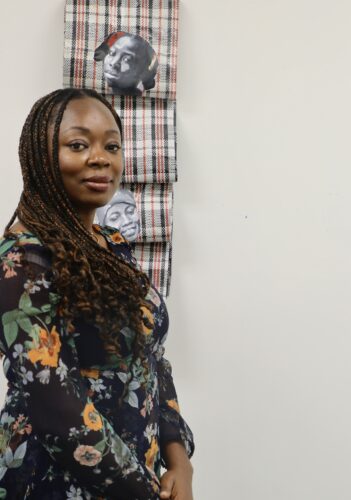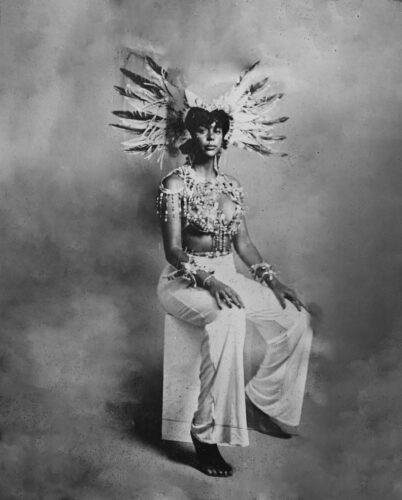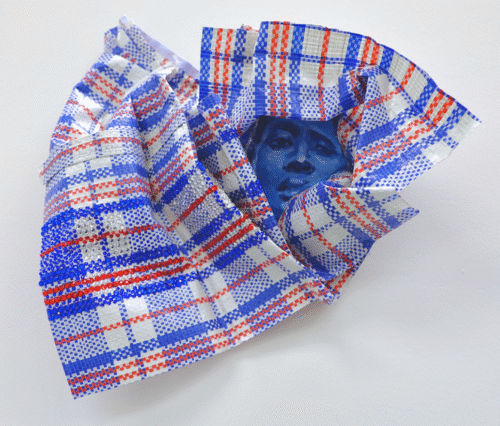Artburst Extras
DVCAI Asks Artists ‘What’s In Your Container?’

A cozy armchair and a meaningful book create reflections as part of
Shayla Marshall’s installation “Relay (AURA),” part of DVCAI’s “The Container Project: What’s In Your Container?” opening Thursday, Nov. 20 at Barry University. (Photo courtesy of the artist)
What do we take when forced from our homes, or when leaving our home country? It’s a question, practical yet conceptual, and explored in the latest collaboration between the Diaspora Vibe Cultural Arts Incubator (DVCAI) and Barry University’s Institute for Immigration Studies. “The Container Project,” which opens Thursday, Nov. 20, and runs through April 17, 2026, at the Monsignor William Barry Library, asks its 19 participating artists, “What’s in Your Container?”
Answers range from memories and adornments of the body (the first “container”) and commentary about migration to re-conceived versions of long-gone objects. Artists represent the Caribbean diaspora, immigrants from other countries and U.S. natives. Many are based in South Florida.

Amarachi Odimba stands in front of one of the pieces from her “Enfold” installation, which combines portraits with an iconic travel accessory. (Photo courtesy of
the artist)
The show has a special resonance as immigration is front-and-center in the American experience – both for those facing deportation and within the larger community. Many of the artists channeled it into their works.
In the series titled “Enfold,” Nigerian-born Amarachi Odimba has cut, stitched and altered the ubiquitous blue, red and black plaid carryall often used by migrants into a wrapping for her painted portraits. Popularly known as the “Ghana Must Go,” bag, they are deconstructed by Odimba as a vehicle to “explore the cultural identity and the diasporic experience, intertwining personal narratives with collective memory,” she writes in a statement about the work. The folded, sewn and warped materials “create a tension where figures seem to merge and undulate, mirroring the contours of the fabric,” she continues. It is a metaphor, she says, for the diasporic experience: “An individual navigating precarious realities while also existing as a distinct entity shaped by displacement.”

“Dispenser” by Michael Elliott. The artist has repurposed the function of the gumball machine. (Photo courtesy of the artist)
Others examine the fate of those who already made the journey. Michael Elliott’s painting “Dispenser” depicts an old-time gumball machine filled not with treats, but with the round, hopeful heads of immigrants. The machine, Elliott writes that the work references and comments on a system “that has us contained but at any moment we are all dispensable ready to be chewed up and spat out as the imperial powers see fit.”
The installation “Tales of Our Matriarch,” by Shayla Marshall includes evocative oversized black-and-white photos of Black women, “honoring the legacy of our grandmothers, women of promise whose sacrifices shaped the way we exist today,” according to the artist. The installation includes a cozy arm chair and a copy of “Their Eyes Were Watching God,” the seminal Zora Neale Hurston novel. One can’t help consider the relationship of the portraits to those who came before us and witnessed life in their own time.

“Hollow (Oven)” Patricia Cooke’s fabric oven, creates a feeling of warmth amidst the insubstantial (Photo courtesy of the artist)
“The Container Project” is curated by Rosie Gordon-Wallace, the founder of DVCAI and known for showcasing and supporting Caribbean diaspora art, and Breeana Thorne, a Los Angeles-based independent curator whose practice weaves together art, community engagement, wellness, ecology and heritage. For both the show speaks to personal issues.
Gordon-Wallace, a pillar of the Miami art community, has fond memories of U.S.-based aunts and uncles sending barrels of “goodies” to the family in Jamaica. “I held those memories all my life,” she says, and asks, “How are people managing all these emotions, all the things that happen to us?” Those recollections, and the current upheavals helped coalesce her thinking about the project, as did discussions with Thorne.
Thorne and Gordon Wallace met at The Harvey B. Gantt Center for African-American Arts + Culture in Charlotte, N.C., years ago. They kept in touch, particularly after the January 2025 Los Angeles fires when Thorne was forced to evacuate. “I had to pack my things and leave,” says Thorne. Among items grabbed: books read and annotated by her much-loved grandmother. Thorne’s home was saved but an aunt and uncle weren’t so lucky. Still, she says, the crisis was followed by “a lot of beauty, seeing people and the community try to collect resources and help people they don’t even know.”

Shayla Marshall’s “Gaia, Painter of Black British and Jamaican Descent,” pays homage to those who came before. (Photo courtesy of the artist)
That included working to salvage and preserve photos and films, while reflecting on how chosen physical objects are accompanied by memories, culture and knowledge – and how those might manifest in a new home. “With immigration, you are leaving a physical space for the betterment of yourself and your future lineage,” says Thorne. “You yourself become the container.” Cultural images and references “become a blueprint you transfer to your offspring and family.” One example often cited, she says: cooking your favorite foods from your country of origin.
Among Thorne’s antecedents are immigrants from Mexico and Barbados. Her grandmother, in particular, carried on the traditions of her heritage, and was the moving force behind creating and publishing a book of family recipes.

Nigerian-born Amarachi Odimba has cut, stitched and altered the ubiquitous blue, red and black plaid carryall often used by migrants into a wrapping for her painted portraits. (Photo courtesy of the artist)
She wants visitors to investigate their own idea of container. “It is very dynamic and engaging,” she says of “The Container Project.” People should leave the show invigorated, and understanding “what the container can be in your own body – a moment of transcendence,” and the many ways in which narratives of transition can be expressed.
“Hollow (oven),” a pink fabric stove and cooking implements by local artist Patricia Cooke, exemplifies memory transformed. “The kitchen is the heart of any home,” she writes. This is where we gather, nourish our bodies and those of our loved ones….”Hollow (oven)” is a container for possibilities, both for what is for dinner, and what the sustenance provided will allow us to do.”
WHAT: The Container Project
WHERE: DVCAI at Barry University, Monsignor William Barry Library, 11300 NE 2nd Ave., Miami
WHEN: Opens Thursday, Nov. 20, 2025 through Friday, April 17, 2026. Visit during regularly scheduled library hours: 7:30 a.m. to 10 p.m., Monday through Thursday; 7:30 a.m. to 8 p.m., Friday; 9 a.m. to 8 p.m., Saturday; 10 a.m. to 10 p.m., Sunday. (Closed Wednesday, Thursday, and Friday, Nov 26, 27 and 28, 2025). Check library website for other closures and exceptions.
SPECIAL EVENTS: 6 to 9 p.m., Thursday, Nov. 20, featured performance at 7 p.m. by Asser Saint-Val, “TUAPUTI,” an interactive art installation and performance; 2 to 4 p.m., Saturday, Nov. 22, “Telegraph Valley,” performance and artist talk by L.A. Samuelson.
COST: Admission to show is free, tickets to performances require a ticket.
INFORMATION: (786) 306-0191 and disaporavibe.org
ArtburstMiami.com is a nonprofit media source for the arts featuring fresh and original stories by writers dedicated to theater, dance, visual arts, film, music and more. Don’t miss a story at www.artburstmiami.com.
